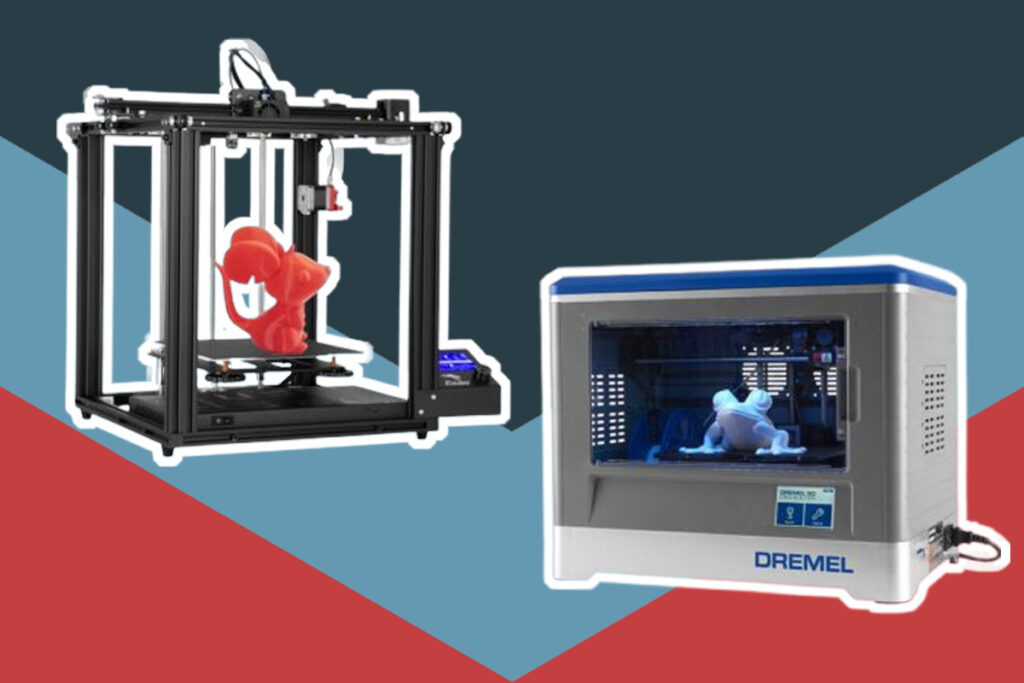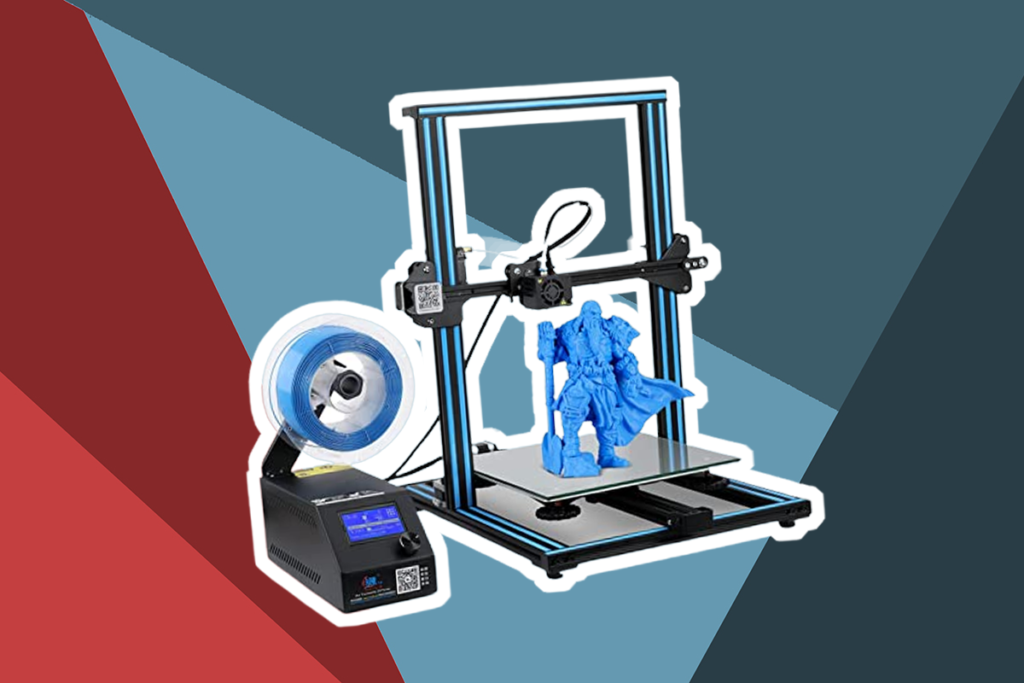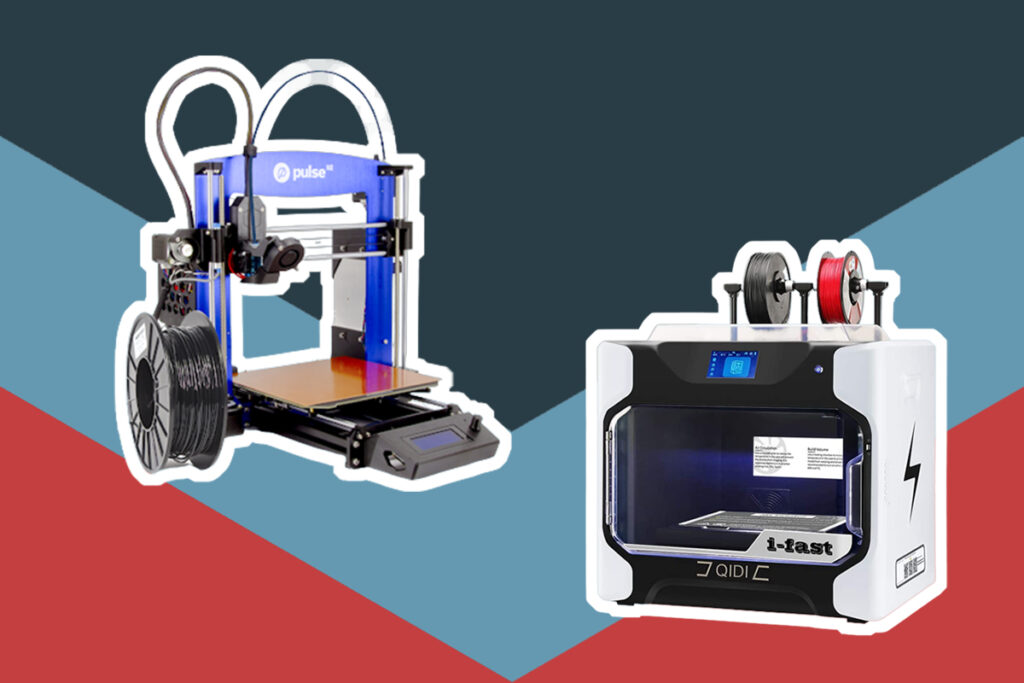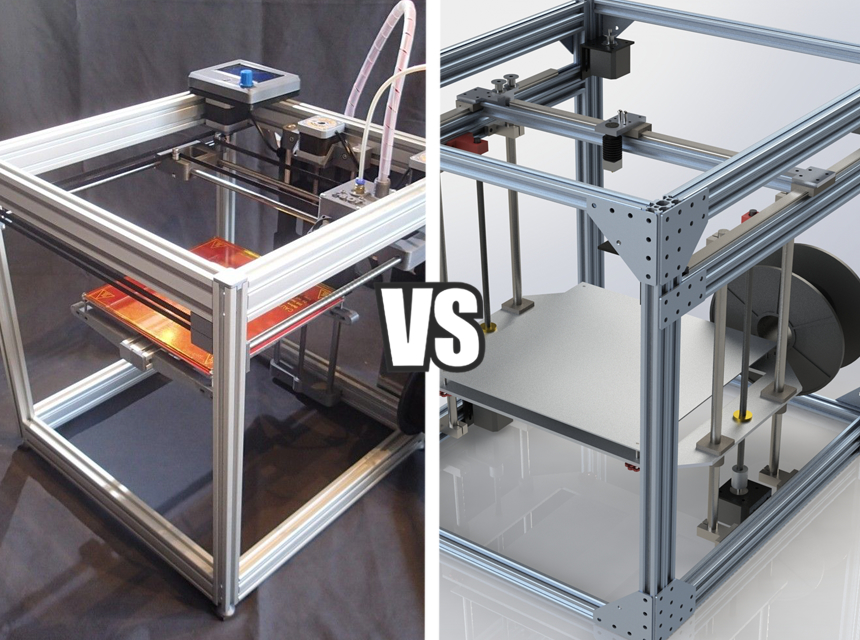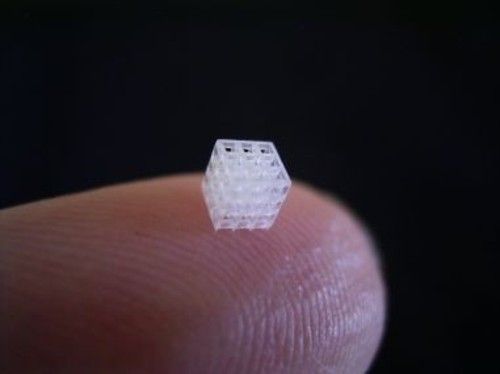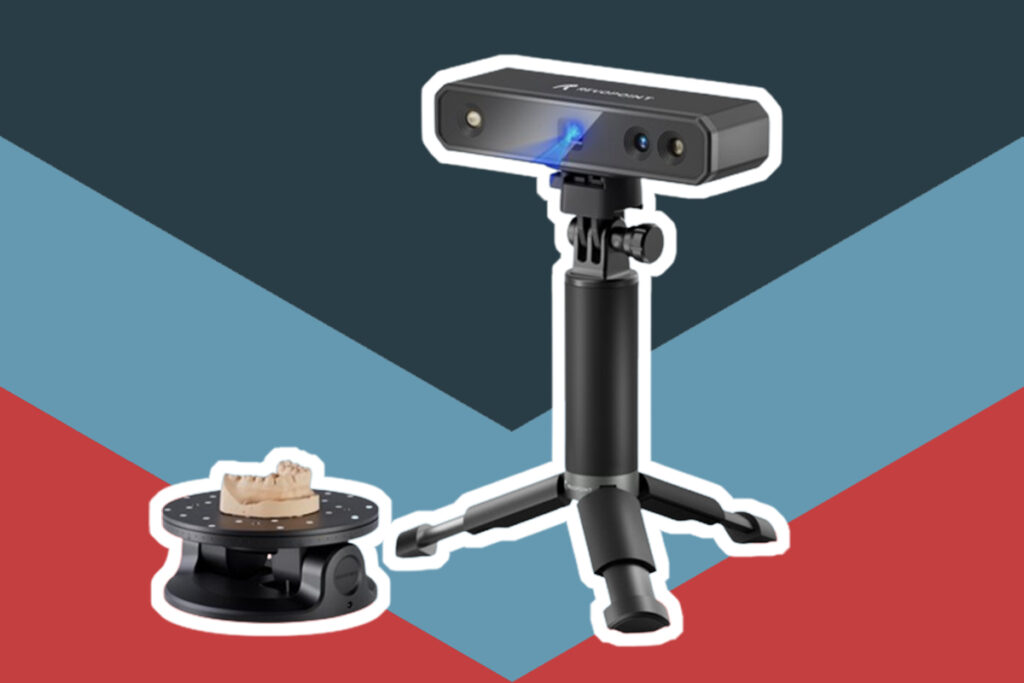

Despite being somewhat pricey and high maintenance, the benefits of a dual extruder 3D printer are obvious. They can simultaneously print multiple filaments in different colors, or two pieces at a time.
Following their benefits, the current market is flooded with a wide range of dual extruder 3D printers’ options, which makes selection quite daunting. To pick the best dual extruder 3D printer, therefore, consider your budget and specific 3D printing needs, such as your preferred printing speed, printing size, 3D printer design, printing method, compatible filaments, printing modes, and other features.
After scouring through numerous reviews, product descriptions, and expert views, here is what we consider as the top eight dual extruder 3D printers in the current market. These printers have something to offer for both home and industrial users.
Compatible filaments: TPU, PVA, PLA, ABS, HIPS, WOOD, PETG, flexible nylon
TENLOG TL-D3 Pro boasts mirror mode and duplication mode printing. As such, you can print two symmetrical models of different filaments and colors concurrently. You can also print two identical models of different filaments and colors concurrently.
With it, you can employ two different filaments to 3D print soluble supports like PVA. That way, you can accurately achieve difficult-to-place print-outs.
The printer also boasts a resume printing function. The function is helpful in case of a power surge or outage, as the control board can recall the last position of the extruder. Once the power is restored, the printer resumes printing from the recalled position.
Added to that is a filament runout detection function, which detects when filaments like ABS or PLA are broken or used up. In such cases, the printer saves the information and suspends printing until the filament is refilled.
What’s more? TENLOG upgraded borosilicate bed allows prints to adhere without warping. That results in ultra-smooth end products
Better still, the printer uses a powerful near-end silent motor and direct drive extruder to print filaments, such as PLA, PVA, TPU, HIPS, ABS, Nylon, PETG, WOOD, and flexible Nylon.
What we liked:
We liked that TENLOG TL-D3 Pro is super accurate to +0.1mm on E1 Z and -0.2mm on E2 X. It’s also easy to set up and use. Better still, its heated bed is equipped with a strain relief, which is important to prevent warping. The chilly on top is its resume printing function that helps the printer to resume printing from the last recorded extruder position. As such, you don’t have to worry about power interruptions.
What could be better:
TENLOG TL-D3 Pro is pricey. Its wire management could also use some organizing. Also, there’ve been reports of warped bed – with the middle of the bed remaining 0.5mm from the nozzle.
Compatible filaments: PLA, PLA Color Change, ABS, ABS Pro, Pearl, Elastic, PVA, HIPS, PETG, TPE, TPU, PP, Conductive Filament, Flexible Filament, Metal Filled Filament, Wood Filled Filament
FlashForge Creator Pro boasts a sturdy metal frame, which is more stable than the original wooden frame. The 6.3 mm aluminum platform is warp-resistant and remains level even under high heat.
FlashForge Creator Pro also boasts upgraded support – from plastic supports to high-heat resistant metal platform supports. The new heavy-duty z-axis guide rod ensures precise and steady movement. While the new acrylic cover serves to protect and insulate your ABS prints of diameter up to 1.75 mm.
The LED lights light up the printing area while the integrated LCD screen helps you monitor the printing process without having to remove the acrylic cover. opening the door. Their button board functions are error-free and the SD slot is repositioned for convenient access. So making any alterations to your design while printing is in progress is manageable.
The printer is compatible with multiple filaments, including PLA, ABS, ABS Pro, Pearl, PLA Color Change, Elastic PA, TPU, HIPS, TPE, PP, PETG, Flexible Filament, Conductive Filament, Wood and Metal Filled Filament. It’s also compatible with different software, such as Simplify3D, FlashPrint, and REplicatorG. When it comes to operating systems, the printer is compatible with Mac OSX, Linux, and Windows.
What’s more? FlashForge Creator Pro is backed by free email support offered by skilled technicians, and a full manufacturer’s warranty. It also comes equipped with a manual for better use.
What we liked:
We liked that FlashForge Creator Pro has a short learning curve. We also liked its wide range of compatible filaments, software, and operating systems. Moreover, the printer boasts an innovative design and functions that are sure to take your 3D printing creativity to another level.
What could be better:
FlashForge Creator Pro is high maintenance as its nozzles require regular replacement. Its nozzles are somewhat at the same height; as such, filaments from the two nozzles can knock into each other, ruining the print. You’ll also require a Simplify 3D to make the most out of the printer.
Compatible filaments: ABS, PLA, PVA, HIPS, etc.
Flashforge Dreamer is an advanced desktop 3D printer manufactured by the same brand that created the popular Creator Pro, Creator X, and Creator. The printer is a testament to what great minds can do when put together.
It boasts a sleek design that’s backed by performance advances. Among the features are a fully enclosed body, a built-in SD port, Wi-Fi connectivity, a high build volume (230 x 150 x 140 mm), a high-resolution color touch screen, lifetime support by skilled technicians, and a full manufacturer’s warranty.
Better still, the printer is affordable than its counterparts. As such, you enjoy the latest technology and the peace of mind that comes from buying from a reputable brand.
Think about it. The enclosed chamber protects and insulates ABS prints while the HD IPS touchscreen and built-in Wi-Fi makes uploading of the files to be printed, a breeze. At the same time, the 4g memory helps store printing files and folders.
The printer is compatible with Slic3r and Skein forge slicing software. It; however, comes equipped with the FlashPrint slicing software. It’s also compatible with MAC OS and Windows 7, 8, and XP operating systems.
What we liked:
The Flashforge Dreamer is a sizable build for its price. Its printing speed is commendable – at least 75 microns – given its high-quality resolution. It also comes equipped with Flashprint, which is a great slicing software. Its affordable price makes it one of the best budget dual extruder 3D printers.
What could be better:
The spool size and location can use improvement. At the current state, you’re better of using an external spool holder or print upgrades.
Compatible filaments: PLA, ABS, TPU, TPE, HIPS, PC, PETG, Nylon, ASA, PP, PVA, glass fiber infused, carbon fiber infused, metal fill, wood fill, etc.
Raise3D E2 Desktop 3D Printer is a fully enclosed, easy-to-setup, easy-to-use, and durable printer that’s specially designed to boost precision standards and scale production.
Its key features include Independent Dual Extruder (INDEX) technology with duplication and mirror printing modes. As such, Raise3D can print different objects concurrently, significantly reducing the printing time.
The printer is regarded as the best dual extruder 3D printer with auto-leveling thanks to its tech-inspired auto bed leveling. Raise3D E2 boasts a video-assisted offset calibration system for the best results. It also features safety functions like automatic pauses whenever the printer’s door is opened.
Better still, Raise3D features a power-saving button that turns off the LED lights and RaiseTouch to save energy. Added to that are power loss recovery functions, flexible build plate for easy print removal, HEPA air infiltration, and filament run-out sensors.
E2 build plate supports up to 110°C and extrudes at temperature up to 300°C. Thus, the printer is compatible with 1.75mm filaments, such as ABS, PLA, PC, TPU, HIPS, ASA, PP, and TPE. The printer also boasts multiple connectivity options, like a USB port, Wi-Fi, a live camera, and LAN. Its onboard 7-inch touch screen has integrated setting controls and on-screen assistance. Added to that are print progress and visual model selection that create an intuitive and user-friendly 3D printing experience.
What we liked:
We liked that Raise3D has an intuitive user interface that guides you through the entire process – from printing to calibration. Think of precision bed level mapping and dual extruder alignment.
What could be better:
On the downside, Raise3D is pricey. The high price is justified by the intuitive and innovative features.
Compatible filaments: PLA, ABS, TPU, PETG, Nylon, PC, Carbon fiber, etc.
R QIDI TECHNOLOGY i-fast is an industrial-grade structure, with a large print size (360 x 250 x 320mm) and a dual extruder for fast printing. The printer uses a 2g Qidi dual Z-axis structure, while its motion structure is upgraded to a linear structure. The ruby extruder results in a faster and smoother filament extrusion. That combined with a high printing accuracy increases the printing speed by 20%. In fact, the device can print easily at 100 ccs.
iFast is compatible with multiple filaments, including ABS, PETG, PLA, PLA+, and Nylon. Its heated chamber can gain temperature up to 60°C. The printer also boasts an excellent mechanical structure that yields robust manufacturing-grade parts.
The printer features an automatic dual extruder, which can adjust the right and left extruder according to the software. It also boasts a water-soluble (PVA) support making it ideal for printing manufacturing-level parts that require complex structures. It also helps realize precision manufacturing.
What’s more? iFast has a user-friendly interface and an excellent user experience. It’s equipped with slicing software that permits normal and expert printing modes. The normal printing mode is ideal for beginners thanks to its preset parameters. Expert printing mode is ideal for 3D printing gurus who can easily modify parameters and personalize printing models.
What we liked:
We liked the i-Fast automatic dual extruder. When the inactive nozzle is “idle”, it lifts and drops the other nozzle. It has an in-built camera for easy observation and monitoring of prints. And its excellent features are backed by great after-sale services.
What could be better:
i-Fast heated bed temperature is on the lower end (60°C) limiting the number of compatible filaments.
Compatible filaments: PLA, ABS, TPU, PETG, HIPS
QIDI TECH X-Pro 3D Printer is equipped with the current dual extrusion technology, making it one of the leading printers in engineering, education, and design hobby printing.
The printer features an upgraded 4.3” touch screen and conditional breakpoint printing for easier and smarter operation. Its 6mm aviation-grade aluminum platform is durable and resistant to high temperatures. As such, it can be heated up to 120°C, making it compatible with a wide range of filaments.
Added to the platform is a removable curved metal plate, which makes it easy to remove the end-product after printing. It can be used repeatedly, and its mobile nature minimizes offsets or damages to the build plate. The support rod is upgraded to 12 mm and features upgraded parts, such as mechanical structure, motor, and mainboard to ensure more stable printing.
Better still, the printer has a power breaking point function that saves the breaking point. This function is particularly helpful in case of a power outage or bulk projects that cannot be completed in a single printing cycle.
The featured QIDI Print slicing software is easy to use. It’s also customizable based on your time and quality preferences. The equipment is compatible with Simplify 3D slicing software, just in case the in-built version is not at par with your 3D printing needs.
The quality features are backed by their one-to-one QIDI TECH customer service and a free one-year warranty.
What we liked:
QIDI TECH X-Pro 3D Printer is useful for schools and home users. It’s easy to set up and use. It’s also low maintenance, with commendable print quality.
What could be better:
The filament guides/support are somewhat fiddly when positioning them to the right height above the printer. Also, the need to apply a little glue to the baseplate before printing can be cumbersome to some.
Compatible filaments: ABS, Polylactic Acid, Polyethylene Terephthalate Glycol, Wood, High Impact Polystyrene Sheet, Polyvinyl Alcohol, Aluminum
GEEETECH A20M delivers mix-color prints enriching your 3D printing experience. The printer aims to provide you with a memorable printing experience and quality end-products. This is evident in its detailed user annual and color mixer guide.
A20M is easy to assemble and use. Think of installing the printer with your kids as a family fun assemble-game.
Its large build volume (250 x 250 x 250 mm), coupled with the 3D touch, and mix-color printing takes your 3D printing creativity to the next level. The 3D touch enhances the adhesion of the first layer, which, in turn, reduces your printing time. Note, the auto-leveling kit is not included in the box – you’ve to purchase one yourself.
Added in the design are the 2-in-1 hot-end and the tri-extruder module, which further enriches your experience.
Its break-resuming capability allows it to continue printing from its breakpoint. This makes it ideal for printing large models. Moreover, GEETECH A20M boasts an open-source control board that offers more possibilities to twerk your printing models.
While at it, the 360-degree ventilation design enhances heat dissipation to guarantee printing quality and quantity.
What we liked:
We liked that GEETECH A20M is easy to assemble, as the assembly instructions embody pictures with basic explanations. It also boasts a lot of features and a commendable print quality for its price. As one of the best cheap dual extruder 3D printers in the market, it’s amazing what you can do with it.
What could be better:
Our only gripe with GEETECH A20M is the lack of factory belt tension. But this is not a big issue. After all, it’s an open-source machine – you can print those tensioners and get to enjoy your 3D printing.
Compatible filaments: ABS, PLA, HIPS, TPU, PETG, Nylon, PC, Carbon fiber
BIBO 2 boasts a sturdy frame, a 6 mm aluminum composite panel. The frame is more precise and stable than its plastic counterparts. The printer is also enclosed with a front door and acrylic hood to ensure optimal temperature control. This makes printing with ABS filaments easier. The covers are also easy to remove for optimal cooling, making the printer suitable for PLA filaments.
BIBO 2 features easy-to-print support structures. For example, when using dissolvable materials, the support filament dissolves away steadily, leaving only the end-product.
Better still, BIBO 2 can print two similar objects concurrently, reducing the printing time by approximately 50%. It also features a programmed G-code file that alerts you when it’s time to use a different color. That makes two-color printing a breeze.
Its full-color touch screen is user-friendly while the WIFI control allows you to control the printing process through the PC or phone.
Added to that is a filament detection function that proves useful for big volume object printing. Here, if the filament runs out, the machine automatically stops for you to refill the spool.
Furthermore, BIBO 2 is unaffected by any interruptions (power cut or otherwise). The printer resumes printing from its last recorded extruder point. That eliminates the need to start from scratch or ending up with an incomplete end-product. Overall, BIBO 2 is the best dual extruder 3D printer for home.
What we liked:
BIBO 2 is loaded with useful features. Its setup is easy – you can get beautiful prints without massive leveling or adjusting. It’s also compatible with numerous filaments. The detailed manual and video tutorials are the icings on a tasteful cake.
What could be better:
BIBO 2 can do better with an easier way to interchange the nozzles used to mount the laser. The laser engraver can also use better documentation.
Thus far, you have gone through what we consider the top eight dual-extruder 3D printers. To narrow it down from eight to one, you should factor in your budget and specific 3D printing needs. Your needs will be a guide to determining which dual-extruder 3D printer features are a must-have and which can be foregone. On top of that, you should understand how a dual-extruder 3D printer works, and some of the things you can do with it.
A dual extruder 3D printer can print faster than a single-extruder 3D printer. The reason is, you don’t need to exchange printing materials during the printing process. As such, the time that would have otherwise been spent replacing the filament whenever the designs require such is saved.
Note, the printing speed of a dual extruder may be the same as that of a single extruder 3D printer. The reason being, most dual extruder 3D printers lack independent extruders. So time is not saved in terms of printing speed, rather in terms of reduced delay and increased precision.
However, some manufacturers have taken their design a step further to create independent dual extruders. For example, Raise3D boasts an Independent Dual Extruder (INDEX) technology with duplication and mirror printing modes. As such, Raise3D can print different objects concurrently, significantly reducing the printing time.
Besides the reduced printing time, a dual extruder lessen the risk of getting electrocuted or burned while changing filaments. The dual extruder also ensures continuity of work in case one extruder breaks down or stops working – for whatever reasons.
In addition, these printers enable you to print different filaments or colors simultaneously. That, in turn, boosts your 3D printing creativity, while increasing the printing opportunities you can explore.
A dual extruder 3D printer works through continued extrusion.
Extrusion includes a die – a manufacturing tool for shaping or cutting the printing material. Then there’s the printing material that is pushed through the “tool” to form a particular shape. Now, the extruder serves to thrust the filament through the die. Think of it as the mechanism that pushes the toothpaste out of its tube.
Generally, the printing material (whether cornstarch-based or oil-based plastic) is in a thin thread referred to as filament. But in large-scale industrial or commercial 3D printing, the material is often in bulk form. In such a case, the bulk material must be extruded to produce filaments, which are applied in lines or layers to produce the desired objects.
The extruder is driven by a mechanical gear shaft that thrusts the filament into a heated bed. 3D printers use fans or other ventilation designs to maintain the right temperature for the material underuse. The cooling ensures that some of the material remains stiffer than the other, to provide the necessary pressure required for printing.
As technology advances, it’s easier to place the filament precisely where it’s needed. It’s also possible to place even the most intricate strands into the extruder.
With the budget and specific needs in mind, it’s time to select your preferred features. As such, consider the following:
Different dual extruder 3D printers use different printing methods, with the common being a fused deposition modeling (FDM). Most of the 3D printers on our list use the FDM printing method. However, there are 3D printers like Raise3D and FlashForge Creator Pro that utilize the FFF printing methods.
An FDM printer prints by heating the material (filament), feeding it into the extruder, and thrusting it into shape along the 3D axes. FDM printers work similar to the 3Doodler Create+, but they’re more precise. FDM printers are grouped into different styles, such as Delta and Cartesian styles. The Cartesian FDM printer is particularly popular with 3D printing hobbyists.
Stereolithography (SLA) printers, on their end, follow a photo-solidification process. Here, the layers are a result of chemical reactions. SLA printers are precise and result in smooth and high-quality prints.
Digital light processing (DLP) printers are similar to their SLA counterparts. They use vat polymerization to create object layers. Here, light is targeted on a point in the resin, which reacts by solidifying in place. The resulting prints are smooth and fine-detailed.
Overall, there are more types of printers in the market (think FFF, SLS, and more), but most hobbyists use FDM printers, before upgrading to other types
In the 3D printing world, the largest part a printer can build is called its build volume. The volume can be cylindrical as in the case of Delta 3D printers or cuboidal. For example, TENLOG TL-D3 Pro has a build volume of 300 x 300 x 350 mm, while BIBO 2 has a build volume of 214 x 186 x 160 mm.
The build volume can be filled with one large part or many small parts, depending on what you’re creating. But if your model is larger than your printer’s build volume, you’ll have to print the model in parts and join the parts later using screws or glue.
As such, you should settle for a build volume that’s larger than the size of your largest model or part of the model. That means, if you’re an architect, you should be looking for models with large build volumes, 600 x 600 x 600 mm and above.
Note, a large build volume comes at a higher price. Thus, factor in your budget and settle for the largest build volume your budget can allow. Moreover, the larger the build volume, the more material is consumed! So, select wisely.
The printing speed determines how fast the motors of your 3D printers move. That is the extruder motor(s), as well as those controlling the axes.
Generally, too slow printing speed can cause deformation while too fast printing speed can cause overheating as a result of insufficient cooling. Too fast printing speed can also cause weak layer adhesion, under extrusion, and ringing. The sweet spot printing speed; therefore, is the fastest your printer can go without compromising the print quality.
To achieve optimal printing speed, the printing speed setting is split into:
The printing speed is also affected by the amount of filament and the filament thickness, each layer of the print is extruded. It’s also affected by the travel speed (when not extruding plastic) and retraction speed (how fast the filament is pulled back before the travel moves).
The overall printing speed of a dual extruder 3D printer is provided by the manufacturer in mm/s. For instance, FlashForge Creator Pro runs at 100 mm/s while BIBO 2 runs at 350 mm/s. And the higher the speed the better, or rather the lesser the printing time.
3D printers use a spool of filaments created from a variety of materials. The common materials are plastic like ABS, PLA, and PETG. But you can also find unique printing materials like wood-based filament.
Printing materials can either be a standard resin or a tough resin. Standard resin comes in gray, white, or clear color. It’s suitable for printing prototypes or small gadgets. But it’s not sturdy enough to create final products.
Tough resin, on its end, is more physical resistant making it ideal for engineering applications and professional settings.
As such, you should determine your 3D printing needs, select the type of resin required, and determine whether your printer of choice is compatible with the resulting filaments.
Luckily, all the dual extruder 3D printers on our list are compatible with a wide variety of filaments – you cannot go out of options.
Dual extruder 3D printers comprise many parts, including gears, wheels, nozzles, motors, and more. As such, they come with varying nozzles diameters and can print varying layer thicknesses. For example, TENLOG TL-D3 Pro has a nozzle diameter of 0.4 mm and can print a layer thickness of 0.1–0.4 mm. On its end, a FlashForge Creator Pro has a nozzle diameter of 0.4 mm and can print a layer thickness of 0.1–0.3 mm.
Overall, a dual extruder 3D printer can benefit from using more gear stages. Using gear stages helps speed up the filament extrusion process. If used, the gears must be strong, precise, and reliable. They must be made of heat-resistant material, be well-lubricated, and placed in a conducive environment for optimal functionality.
The extruder wheel is also significant. The wheel pattern should provide adequate grip to maintain the shape of the filament without shearing effect. When it comes to the wheel size, the radius should be large enough to ensure adequate contact between the wheel and the filament. However, the radius should not be too large to require large components and torque.
Dual extruder printers can print in:
In the single extruder mode, the printer is operated using a single extruder. As such, the supporting extruder remains idle. This printing mode is ideal for a small project that requires one filament type and color.
In the dual extruder model, both nozzles work together to print a single object in multiple colors or filaments.
In the duplication printing mode, the nozzles move simultaneously to print two similar objects in terms of size, orientation, and angle. While in the mirror mode, two independent dual extruders work simultaneously to yield two identical or symmetrical printouts.
Raise3D E2 on our list has an independent dual extruder (INDEX) technology that makes it ideal for anyone interested in printing in all four modes at one point in their 3D printing life.
When it comes to colors, dual extruder 3D printers can print in mix-color, gradient color, dual color, and single color. Therefore, determine the printing mode that best suits your needs and select a 3D printer that offers the same.
3D printers use software from 2 sources: the computer (slicer) and the printer itself (firmware). Slicers convert your digital models into printing instructions referred to as G-code. The printer then executes the G-code to produce a physical version of your digital one created as the result of 3D modeling.
The slicer cuts your model into slices (horizontal layers) that are printed sequentially. It also creates internal paths and structures for printing the models, alongside external structures, such as supports.
Most 3D printers have in-built slicers. For example, QIDI TECH X-PRO has a QIDI Print slicing while Flashforge Dreamer has a Flash Print dedicated slicing software. If you have a favorite slicing software (say, Cura, Slic3r, or Simplify 3D), select a 3D printer that’s compatible with the software.
There’s nothing like to safe when dealing with hot electrical equipment. Thus, look for safety features that will enhance your 3D printing experience. Features like an automatic nozzle cooling after printing, automatic heated bed shut off once printing is complete, automatic filament retraction when printing is paused or complete, and so on.
A 3D printer with a print resume function is a plus. Luckily, most of the printers on our list possess this feature. Print resume function ensure your printouts are not interrupted by unexpected pauses – think power outage, bulk models, filament running-out, and more.
The same goes for a heated bed, a feature that strives to lay a strong foundation for your printouts.
Easy axis adjustability is another plus. Thus, select a 3D printer with an easily accessible belt tension adjustment. A.k.a. you won’t have to remove some components to make adjustments.
While at it, settle for a printer with a touchscreen user interface. Don’t waste time navigating a menu using a rotary knob.
Given a dual extruder 3D printer price tag, it’s obvious you need some guarantee from the manufacturer to be at ease. Thus, settle for a printer with at least one year of warranty. In case of a limited warranty, check whether the warranty period can be extended. Or settle for a printer backed by a full manufacturer’s warranty and free email support, like FlashForge Creator Pro.
You’ll encounter a wide range of prices for different 3D printing methods, styles, designs, and features. Generally, FDM printers are more affordable than their counterparts. You can find an FDM 3D printer for as low as $150, while DLP printers go for at least $500.
Thus, if you’re on a limited budget, settle for an FDM printer that boasts your must-have features. You can always upgrade later.
Note, several printers are compatible with a range of materials, such as PLA, ABS, PETG, PP, PMMA, and more. However, it’s best to remember every material listed by the manufacturer will likely require different machine settings.
Generally, though, you should check what materials your printer is compatible with, or purchase a printer that’s compatible with the materials you want to use. Also, check whether there’s available information detailing which settings should be changed for what material.
While at it, check the size of the filament that your printer uses. Is it 1.75 mm or 3 mm?
Besides a slicer, you may require mesh repair software. This is particularly helpful in case of mesh errors that trip up your printer or slicer. Luckily, some 3D modeling tools, like Blender, Fusion 360, SketchUp, and FreeCAD have in-built mesh repair tools. Alternatively, you can use dedicated mesh repair programs.
In addition, you can use print management software to control your machines and organize your products.
Avoid the use of pressured smoothing techniques, as the high vibrations can deform the surface.
Besides sanding, you can apply polishing material to fill or conceal any visible layer lines. Alternatively, use a sandable high-fill primer spray paint. You can also try placing the prints in a sealed container containing acetone mist – this method is known to work well with ABS prints. No matter the smoothing process you use, be sure to work in a well-ventilated space.
Getting the best dual extruder 3D printer is a natural upgrade as you clinch different levels in the 3D printing world. 3D printers will (no doubt) expand your 3D printing opportunities. We have exhausted all we had to say about dual extruder 3D printers, it’s time for our verdict.
Our vote goes to TENLOG TL-D3 Pro thanks to its supper accuracy (+0.1 mm on E1 Z and -0.2 mm on E2 X). It’s also easy to set up and use. Better still, its heated bed is equipped with a strain relief, which is important to prevent warping. The chilly on top is its resume printing function that recalls the printer’s breakpoint and resumes printing from the point.
For the greatest value among the best dual extruder 3D printers, go for FlashForge Creator Pro. It has a short learning curve, as well as a wide range of compatible filaments, software, and operating systems. Moreover, the printer boasts an innovative design and functions that are sure to take your 3D printing creativity to another level.
